2012 Ski-Doo Summit 800 Review [Video]
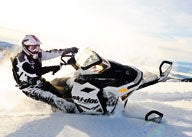
Summits embrace the next step in powder performance
Last month I watched the many YouTube videos on the 2011 and now the 2012 Summits by BRP Video. I agree with what these videos purport and agree that the 2012 Summit, a much refined XP, has evolved to be the powder and mountain master BRP initially designed the XP Summit to be. Time and pressure has produced a diamond.
As the Snowmobile.com mountain specialists we have been critical of the earlier XP Summit’s handling. That’s true. But, after a season on a 2011 XP Summit X 154 with Ski-Doo’s S-36 handling package, we’ve updated our opinions and turned 90-degrees. Now for 2012, the 800-powered Summits are more hauntingly beautiful – where nasty is sweet and bad is good.
In West Yellowstone this past March, Ski-Doo threw 800 Summit after 800 Summit at us to test ride. Ski-Doo believed in its product and had a point to make to us; their most staunch critic.
Point proven. Point accepted.
Get the Flash Player to see this player. |
For model year 2012 Ski-Doo builds three Summit 800s, the Spring-buy only X, the come-in-and buy-it-when-you-want SP (95% X) and the budget-oriented but all-powerful Sport.
For these models, Ski-Doo took the S-36-equipped Summits and gave them more climbing ability, more sidehilling and tree running finesse, and handlebar leverage and rotation that’s mountain specific, depending on model. Ski-Doo’s Mountain Technical Team (MTC) listened to riders, dealers and the press alike, and refined the XP Summit chassis to be flickable and very light through the bars. Gone is the XP fight to keep its skis on the ground when sidehilling and when piloting the Summit in a wrong foot forward stance. Gone too is the XP handlebar slap when hitting a trench on a sidehill slice.
The Summit 800 X and SP are powered by BRP’s Rotax E-TEC electronic direct fuel injected 800 twin that has a displacement of 799.5cc, coming from a bore and stroke of 82mm by 75.7mm. This motor chucks out some gnarly horsepower, approximately 164.
The E-TEC 800R motor is said to use 15% less fuel and 50% less oil than the 800R PowerT.E.K motor. With reduced oil and fuel consumption comes reduced exhaust emissions. The E-TEC 800 uses voice-coil injectors, which control fuel delivery via wire-fed (coil) electric current that acts as an electromagnet to pressurize and release fuel at precise calculated rates. The exhaust valves are 3-D mapped through the computerized control module that allows the two-stroker to efficiently perform (build and hold horsepower) at low-, mid, and high-RPM levels. Because the engine’s control module generates excess heat as it pours through 8,000 calculations or more per second to control engine throttle inputs, Ski-Doo’s engineers built in a liquid-cooled loop to cool the control module.
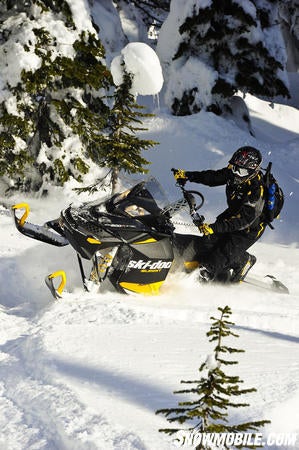 You’ll find the Summits can handle tight runs as easily as wide-open snowfields.
You’ll find the Summits can handle tight runs as easily as wide-open snowfields.
The drive clutch for the three Summit models is BRP’s own TRA VII and the driven is BRP’s QRS; both have wide adjustment ranges, which are needed when hitting the mountains and the changing elevations.
The Sport version uses a motor from 2010 and back, the 800R Power T.E.K. This motor is a carb only motor, yet it has modern techie stuff like BRP’s Digital Program Manager (DPM) which monitors altitude and barometric pressure – to adjust fuel flow – and 3D-RAVE. Horsepower is 150-plus. The 800R P T.E.K. is proven, is tough and viable and has delivered reliable high-altitude performance for many years.
These 2012 Summits use Ski-Doo’s S-36 handling package, which gives the Summit a narrow ski-stance that adjusts from 35.7-inches to 37.4-inches. The S-36 handling package as introduced for model year 2011. The rear suspension front rail shock is extra long, which assists in easy right- and left-of-center roll, and assists in keeping the vehicle flat on ascents. For 2012, there’s a new softer sway bar, which can be easily uncoupled. The S-36 handling package has lifted the Summit to stardom and moved the vehicle from heavy in the bars to fantastically light at the love handles.
Let’s return to the high-end X. The 2011 Summit X 154 quieted our complaints about the early XP Summit’s heavy front end handling. The new 2012 is sweeter still with more finesse.
The new X has an improved all-aluminum tapered handlebar that mimics a motocross bike. Though the Summit retains its over-the-motor steering post (called laydown or horizontal), the new post and handlebar coupling has zeroed-out all quarrels between rider and sled, and has made the Summit X crash-diet light through the bars.
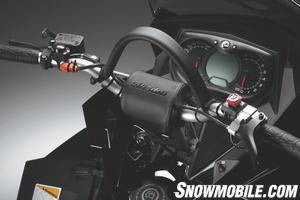 The Summit X handlebars are tapered aluminum and highlight this powder sled’s style.
The Summit X handlebars are tapered aluminum and highlight this powder sled’s style.
For the X, Ski-Doo gave it a minimalist cockpit – simple handwarmer toggle, light dimmer, kill switch and RER (Rotax Electronic Reverse) button. Stationed at the cockpit is a dual analog/digital instrument pod that is minimalist too, but deep in communicating information.
Under its tunnel and mounted to the highly-controlled and smooth SC-5M rear suspension is a new monstrously aggressive track, the Powder Max II. This track for the X-model is the tallest OEM-supplied track, lugs are 2.5-inches. This remarkable track is lighter than the previous year’s 2.25-inch track due to hollow lugs. Remember, the Summit tracks are one-inch wider than the other OEM mountain tracks; width is 16-inches. Track lengths are 146, 154 and 163. With tall lugs and a wide footprint, the Summit X shores itself up as the leader in depth and width.
Published dry weights by BRP for the Summit X are 454-pounds for the 146, 459-pounds for the 154 and 464-pounds for the 163.
The X also comes equipped with seat storage. This new feature built into the XP X seat gives the Summit X an edge over the other OEMs; where the other three have moved away from seat storage. The rear seat compartment is deep enough (1.3 gallon capacity) to hold some nice vitals for that long hard day in the mountains.
The SP, which is 95% X, uses the same Powder Max II track and has the XP X seat with storage. Missing from the SP are the race-inspired aluminum handlebars. Track lengths are the same as the X, 146, 154 and 163.
Dry weights for the SP, according to Ski-Doo are: 459-pounds for the 146, 464-pounds for the 154, and 469-pounds for the 163. The SP model, for all lengths, is five-pounds heavier than the X due the fact the X uses more chromoly, has lighter HPG shocks and the lighter handlebars. One may say the SP is a refined 2011 Everest with a meatier track, awesome seat and softer swaybar.
The Sport uses the Powder Max track that first appeared in 2011. The non-ported track added to the Sport is a 154 only. The Sport is a viable and strong powder sled for the money. The Sport, is liken to a 2010 Everest with Ski-Doo’s S-36 handling package and original Powder Max track. Dry weight for the Sport is 455-pounds.
Much is to be learned about the three Summit models, we encourage you to visit BRP’s website to learn more; study the tech info, compare the models and decide which is best for your needs. With that said, we must give rider impressions.
In Truth
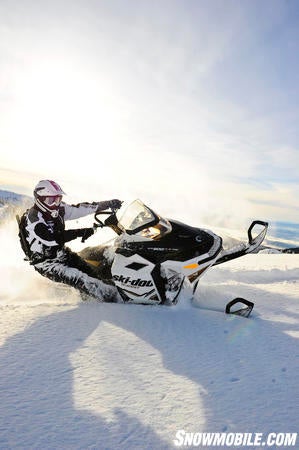 Ski-Doo’s premium Summit X comes in a white and black configuration.
Ski-Doo’s premium Summit X comes in a white and black configuration.
For the X, the new tapered aluminum bars and softer sway bar give it effortless power steering-like control and nearly flat bar rotation. The X has a descent mountain strap, far better than the floppy rubber belt from 2011. The new 2.5-inch paddle Powder Max II under a gentle approach angle, delivers phenomenal flotation and climbing.
E-TEC power is smooth without peaks and valleys and is predictable when rolling in and out of the throttle.
The only nit we uncovered is the kill switch, which it easily falls and stops the motor when reefing on the bars in a standup position. Numerous times my chest protector hit the switch, halting momentum. We’d like to see Ski-Doo roll it forward or build a housing around it.
The 163 is a high climber. If driving a 163, consider shortening the front limiter to keep it flat when ascending. Generally, long tracks, 160-plus tracks, tend to pick up the nose when climbing.
At one point, in waist-high deep powder, I throttled down a hill on a 163 where thick trees blocked the sunlight. Being in charge, I flipped the 163 X on its left side panel, wrong foot forward, and threw down a smartly controlled descent. That felt good.
When first riding the Summits, you may look at the narrow ski stance and wonder if the sled will stay upright on the trails. Don’t worry about it. The Summit with S-36 is as stable as the 2008, 2009 and 2010 when the stance was wide and no S-36 existed. Ride quality is a 10.
Ski-Doo has done well in capturing market need and filling demand. The X, SP and Sport models are serious mountain sleds.
In my opinion the 2012 Summit X 154 may be the best there is on the snow for this upcoming mountain riding season.
In My Opinion — Kevin Allred, Test Rider
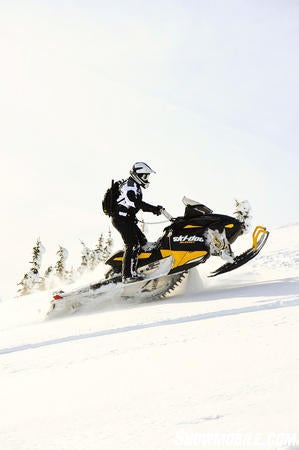 The combination of a powerful E-TEC twin and 16-inch wide footprint makes the 2012 Summit a top performer.
The combination of a powerful E-TEC twin and 16-inch wide footprint makes the 2012 Summit a top performer.
The 2012 E-TEC Summit X sled just plain rocks, its trail and backcountry handling is an outstanding and noticeable improvement from 2011. The new handlebars on the X felt right and the seat storage will be appreciated.
I tried to pick up on any performance loss down the trail by turning the taller track, but could find none. It is lighter than last year’s track. Therefore performance gains in the deep-and-steep came without compromise. What I learned from our 2011 800-class shootout, is that all our 800 mountain sleds were very competitive with each other. If one sled had an advantage over the other it was due to the snow conditions for that day and which track performed best in that snow; the next week, a different story. So the question is will the 2.5 track give the new Summit X and SP the edge? Mmm. I can’t wait.
| 2012 Ski-Doo Summit 800 X | 2012 Ski-Doo Summit 800 SP | 2012 Ski-Doo Summit 800 Sport | |
| Engine | Rotax E-TEC 800R 799.5cc, liquid-cooled twin; direct injection; 3-D RAVE | Rotax E-TEC 800R 799.5cc, liquid-cooled twin; direct injection; 3-D RAVE | Rotax 800R PowerTEK 799.5cc, liquid-cooled twin; dual Mikuni TM40 carbs; single exhaust with RAVE valves |
| Horsepower | 164 (Claimed) — Requires Premium unleaded | 150+ — Requires Premium unleaded | 151 (Claimed) — Requires Premium unleaded |
| Drive | TRA VII with QRS secondary | TRA VII with QRS secondary | TRA VII with QRS secondary |
| Front Suspension | Dual A-arm; HPG Plus gas shocks with coil over springs; 8-in travel | Dual A-arm; HPG gas shocks with coil over springs; 8-in travel | Dual A-arm with lightweight chromoly lower arm; HPG Plus R gas shocks with coil over springs; 9-in travel |
| Rear Suspension | SC-5M parallel rail; HPG Plus shocks; up to 16-in travel | SC-5M parallel rail; HPG shocks; up to 16-in travel | SC-5M parallel rail; Motion Control on front arm with HPG shock on rear arm; up to 15-in travel |
| Length | 127.0 in w/146-in track; 131.3 w/154-in track; 135.6 w/163-in track | 127.0 in w/146-in track; 131.3 w/154-in track; 135.6 w/163-in track | 131.3 in |
| Width | 42.6 to 44.3 in | 42.6 to 44.3 in | 45.6 to 47.4 in |
| Ski Stance | Adjustable: 35.7 or 37.4 in | Adjustable: 35.7 or 37.4 in | Adjustable: 35.7 or 37.4 in |
| Track | PowderMax II with 2.5 lug profile; 16-in width in three available lengths (146, 154, 163) | PowderMax II with 2.5 lug profile; 16-in width in three available lengths (146, 154, 163) | 16x154x2.25 PowderMax |
| Weight | 454 to 464 (claimed) | 454 to 464 (claimed) | 455 (claimed) |
| Fuel Capacity | 10.6 US Gal | 10.6 US Gal | 10.6 US Gal |
| Features | Electronic reverse; chromoly A-arm suspension; multi-function gauge; aluminum tapered handlebar; “X” narrow seat; J-hooks and mountain strap | Electronic reverse; chromoly A-arm suspension; multi-function gauge; “X” narrow seat; mountain strap | Electronic reverse; multi-function gauge; “X” narrow seat; mountain strap |
| MSRP | Spring Only | US $11,499 | US $10,349 |



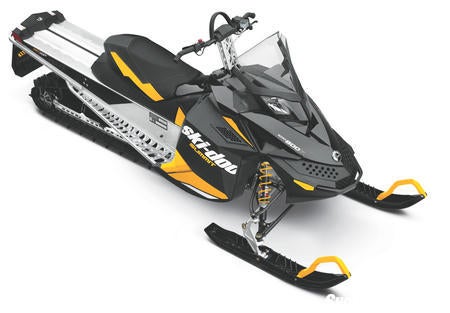
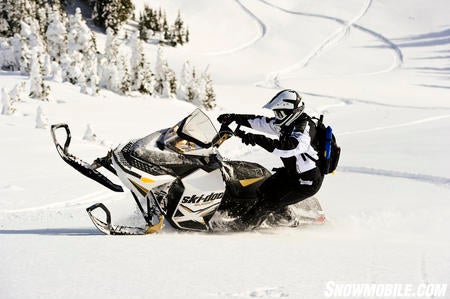
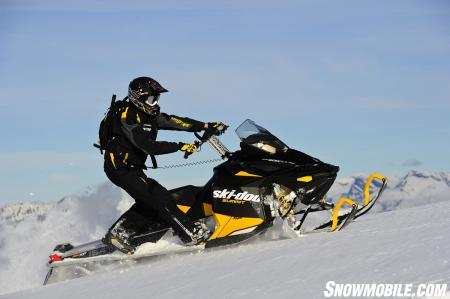

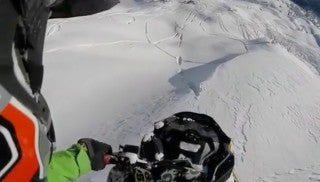
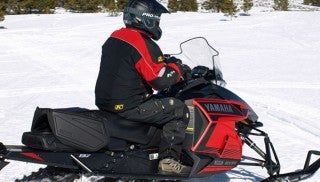


 Your Privacy Choices
Your Privacy Choices